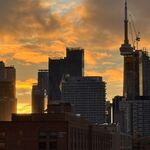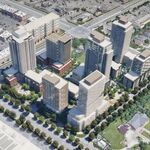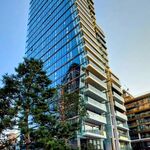Toronto News Releases Unsubscribe
8:37 AM (31 minutes ago)
to NEWS-RELEASES
City of Toronto Media Relations has issued the following:
==========================================
News Release
May 2, 2017
Cultural Hotspot heats up East York and east-end neighbourhoods
From May through October, the City of Toronto's fourth annual Cultural Hotspot initiative will celebrate and spotlight the arts, artists, culture, food, events and communities of East York and east-end neighbourhoods.
"The Cultural Hotspot program entices residents and visitors to experience the diversity and vitality of neighbourhoods they may not already be familiar with," said Mayor John Tory.
Highlights of this year's Cultural Hotspot program include projects produced in partnership with local community arts groups, such as:
• three new summer community arts festivals: East End Arts' multi-day Main Squared Festival, Danforth Village Fair and the Monarch Park Arts and Music Festival
• Cultivating Community through Mural Arts, a large-scale community-engagement mural project bringing together seven East York groups led by VIBE Arts
• Project Future, an innovative and collaborative project combining permaculture gardening, eco-art installation and theatre led by local Indigenous and Black youth, produced with the Children's Peace Theatre
• exciting community workshops concluding in performances and exhibitions such as Animating Danforth East, Dance with Peacock, Riverside Roots, People and Trees, East York – A Living History
• My City My Six, a participatory public art project in celebration of Canada 150 produced by the City in collaboration with six Local Arts Service Organizations
• a HOT Eats culinary program and contest in collaboration with local BIAs and restaurants, and
• a new East York/east-end edition of the Cultural Loops Guide offering self-guided tours that invite people to continue exploring the area for years to come.
The Cultural Hotspot will hold its signature celebration on June 17 at the East York Civic Centre with performances and family events. Residents should consult the program guide for a full list of events.
More information and the program guide are available at
http://www.toronto.ca/culturalhotspot and on social media at
http://www.twitter.com/culturalhotspot and
http://www.facebook.com/culturalhotspot.
Since the Cultural Hotspot's launch in 2014, more than 60,000 people have attended about 180 projects and events presented by the City and its many partners in North York, Etobicoke and south Scarborough. The program has also engaged hundreds of young people in learning and mentorship since its inception.
The Cultural Hotspot is produced by the City of Toronto in collaboration with local arts, cultural, educational and heritage organizations, community partners and local businesses. It builds on existing community strengths while developing resources outside of Toronto's downtown as recommended by the Creative Capital Gains Action Plan.
Quotes below are from councillors whose wards are part of this year's Cultural Hotspot:
“Ward 29 is thriving with cultural activities and venues. From the newly renovated grounds at the East York Civic Centre to the always dynamic and engaging events at Todmorden Mills and the Evergreen Brick Works. The ward also has very supportive arts, community and civic organizations who animate the area with programs, events and opportunities, like the Don Valley Art Club, DECA, East End Arts, and our valued public libraries. Ward 29 is also home to the second highest concentration of cultural workers in the city! I’m looking forward to the new projects by East York Neighbourhood Initiatives and VIBE Arts, Cosburn Arts Centre, Dreamation, inPrint Collective, Spore Contemporary Art Centre, and of course, the Cultural Hotspot launch at the East York Civic Centre on June 17.”
– Councillor Mary Fragedakis (Ward 29 Toronto-Danforth)
“Ward 30 is home to world-renowned artists and is an epicentre for cultural industries, including film, television and digital media. The new Streetcar Crowsnest Theatre serves the community as a theatre, arts facility and cultural hub. The Carlaw and Dundas area has been become an emerging area of culture and creativity. There are many other gems including local galleries, the Danforth Music Hall, the Opera House, the Riverdale ArtWalk, Red Sandcastle Theatre, the Arts Markets, and beautiful murals that animate our streets. Ward 30 is also home to Shakespeare in the Ruff and the Dusk Dances Festival in Withrow Park, the Beaches Jazz Festival along Queen St. East, the Festival of South Asia along Gerrard St. East, and of course Taste of the Danforth. Ward 30 has many wonderful hotspots for all to enjoy.”
– Councillor Paula Fletcher (Ward 30 Toronto-Danforth)
“I am so impressed by the exciting cultural events that seem to grow every year in the East York and Danforth area. We have so many talented people from all over the world who bring their ideas and creativity to our community. Visual art, music, theatre, dance - it’s all here, and it reflects the richness and diversity of our emerging and engaging arts community. Whether I’m attending a 'Danny' BIA music event in a park, watching a Children’s Peace Theatre production, attending a Bangla festival or taking in the East End Poetry Festival, East York has become a place where the arts and community have come together to create a dynamic home for the arts and its cultural workers. This summer, I’m excited to see so many local artists and arts organizations showcased to a wider audience through the Cultural Hotspot program. I look forward to seeing you there!”
– Councillor Janet Davis (Ward 31 Beaches-East York)
“I am thrilled to be hosting the Cultural Hotspot in the east end this year! Our vibrant communities of Ward 32 work hard to make their neighbourhoods a better place to live, work and play. Down at the beach, we have our annual Winter Stations, which ask local students and professional designers to re-envision lifeguard stands into public art installations. Further north, the Gerrard India Bazaar is home to our fantastic South Asian business community who host the annual South Asian Festival. In nearly all of our parks, we have community-led groups who bring together neighbours to animate parks with events and activities. The Danny is home to the Danforth East Community Association, a resident group who has tirelessly organized to empower residents through community involvement.”
– Councillor Mary-Margaret McMahon (Ward 32 Beaches-East York)
This news release is also available on the City's website:
http://ow.ly/r3gj30bm8eQ
Toronto is Canada's largest city, the fourth largest in North America, and home to a diverse population of about 2.8 million people. It is a global centre for business, finance, arts and culture and is consistently ranked one of the world's most livable cities. In 2017, Toronto will honour Canada's 150th birthday with "TO Canada with Love," a year-long program of celebrations, commemorations and exhibitions. For information on non-emergency City services and programs, Toronto residents, businesses and visitors can visit
http://www.toronto.ca, call 311, 24 hours a day, 7 days a week, or follow us on Twitter at
http://www.twitter.com/TorontoCommsand on Instagram at
http://www.instagram.com/cityofto
- 30 -
Media contact: Shane Gerard, Strategic Communications,
416-397-5711,
shane.gerard@toronto.ca









